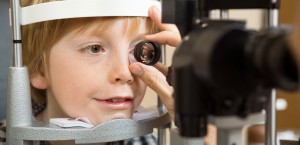In a previous article, we discussed 3 common vision problems in children, but these focused mostly on eye alignment and convergence issues. Of course, as anyone will glasses can attest to, these are hardly the only eye problems children can have. In today’s article, we’ll tell you a bit more about refractive errors – what you probably know as nearsightedness, farsightedness and astigmatism.
What is important to know is that most children are naturally somewhat farsighted – they can see better at long distances than adults. Myopia and astigmatism in young children are less common. In fact, there seems to be a connection between the amount of time children spend outdoors in natural light and their propensity to develop myopia.
Myopia – Nearsightedness
Myopia means that the eye is a bit longer than usual or has a steep cornea, which results in the light focusing in front of the retina. It means that close objects look clear and distant objects are blurry. Children whose parents have myopia are more likely to develop it; however, both parents can have perfect vision and their child can still develop myopia. Some researchers suspect that reading for long periods of time or holding books too close to your eyes may increase the risk for myopia, but there is no conclusive evidence of this.
Your children’s eye doctor can do a vision exam and prescribe eyeglasses or contact lenses to treat myopia.
Hyperopia – Farsightedness
Just as a myopic eye is longer than usual, a hyperopic eye is shorter. That means that light from close objects which should focus on the retina doesn’t – it would focus behind. What it means in practice is that when your child is trying to read a book or do an art project, he may have trouble seeing the page or doing the detail work carefully. Farsightedness can be connected to both amblyopia and strabismus, so it is important to get any suspicions checked out.
Like for myopia, glasses and contacts can both be solutions for farsightedness. Only your pediatric eye doctor can say for sure.
Astigmatism
In astigmatism, the cornea is not perfectly round, but curves more one way than another. The result is distorted and blurred vision for objects that are close up and far away. It is possible to have both astigmatism and near- or farsightedness. In a recent study of 2,523 American children ages 5 to 17, more than 28 percent had astigmatism of 1.0 diopter (D) or greater.
Some types of astigmatism do improve over time without treatment and children can even improve enough not to need glasses. However, this is a decision for your children’s eye doctor to make.
Since untreated astigmatism, just like untreated myopia or hyperopia, can affect your children in school, it’s important to make your child’s eye health a priority. Make an appointment with a pediatric eye doctor today. Contact us and we’ll make sure your child’s vision is healthy!

